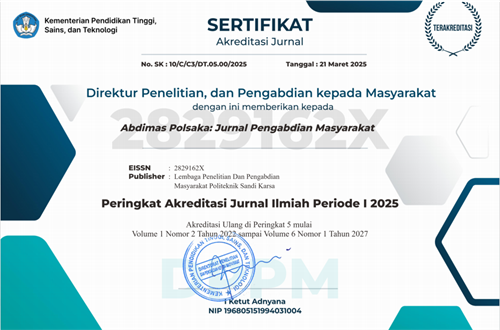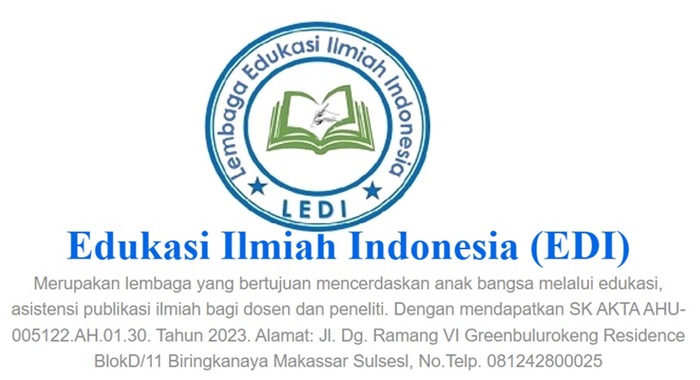Empowering couples of childbearing age to become active family planning acceptors to create quality families
DOI:
https://doi.org/10.35816/abdimaspolsaka.v4i2.104Keywords:
Contraceptive Acceptors, Education, Quality Families, Women of Childbearing AgeAbstract
The Family Planning (KB) Program is one of the government's strategies in controlling the population growth rate and realising quality families. Couples of childbearing age (PUS) are the main target in this program, but many PUS still have not yet become active family planning acceptors, especially in rural and remote areas. This community service activity aims to increase the understanding and participation of PUS in the use of contraceptives through education and counseling. The implementation method involved lectures, discussions, demonstration of contraceptives, and using leaflet media and teaching aids to 20 participants in the work area of the Pattingalloang Health Center, Makassar. The activity results showed an increase in the enthusiasm and knowledge of participants regarding the importance of being an active family planning acceptor. Supporting factors for the activity's success include the support of health workers, cadres, and the availability of infrastructure, while time constraints and the number of participants are obstacles. It is hoped that this activity can strengthen the role of PUS in the success of the family planning program and create healthy, prosperous, and quality families
Downloads
References
S. Z. Putri, S. M. Bachtiar, and S. Suprapto, “A Descriptive Case Series on Combined Education, Breast Care, and Oxytocin Massage for Lactation Support in Indonesia,” J. Public Heal. Sci., vol. 4, no. 02, pp. 165–179, 2025, doi: https://doi.org/10.56741/IISTR.jphs.001030.
A. Akib et al., “Increasing knowledge and early detection of cervical cancer in women of childbearing age through IVA examination,” Abdimas Polsaka, vol. 3, no. 2, pp. 109–115, Sep. 2024, doi: https://doi.org/10.35816/abdimaspolsaka.v3i2.82.
A. M. Iregui-Bohórquez, L. A. Melo-Becerra, M. T. Ramírez-Giraldo, A. M. Tribín-Uribe, and H. M. Zárate-Solano, “Unraveling the factors behind women’s empowerment in the labor market in Colombia,” World Dev., vol. 183, p. 106731, 2024, doi: https://doi.org/10.1016/j.worlddev.2024.106731.
C. Tayal, R. Sharma, and K. Lata, “Association between women’s autonomy and reproductive health outcomes in India,” J. Med. Surgery, Public Heal., vol. 4, p. 100156, 2024, doi: https://doi.org/10.1016/j.glmedi.2024.100156.
U. Marbun and Irnawati Irnawati, “Edukasi Bahaya dan Pencegahan Preeklampsia Pada Kehamilan,” Abdimas Polsaka, pp. 64–69, Mar. 2023, doi: https://doi.org/10.35816/abdimaspolsaka.v2i1.36.
L. Lövgren, “Which rights matters: Girls’ education at the expense of their sexual and reproductive rights?,” World Dev. Perspect., vol. 33, p. 100571, 2024, doi: https://doi.org/10.1016/j.wdp.2024.100571.
U. Marbun, N. Sari, I. Irnawati, L. Sari, and D. Dahniar, “The effectiveness of reproductive midwifery care with the flour albus approach: A Case Study of handling vaginal discharge in women of childbearing age,” J. Ilm. Kesehat. Sandi Husada, vol. 13, no. 2 SE-Book Review, Dec. 2024, doi: 10.35816/jiskh.v13i2.1218.
I. Irnawati and U. Marbun, “Healthy Pregnancy Preparation with Nutritional Fulfillment The Balanced One,” J. Pengabdi. Masy. Edukasi Indones., vol. 2, no. 2, pp. 78–85, May 2025, doi: https://doi.org/10.61099/jpmei.v2i2.96.
M. De Proost, M. Johnston, and H. Mertes, “Egg freezing for young women: A new dawn for reproductive autonomy?,” Best Pract. Res. Clin. Obstet. Gynaecol., vol. 99, p. 102589, 2025, doi: https://doi.org/10.1016/j.bpobgyn.2025.102589.
C. Weingart, C. Toth, E. Berlan, and D. Snyder, “Increasing Contraceptive Prescriptions in Adolescent Females With Documented Interest in Contraception: A Quality Improvement Project,” Acad. Pediatr., vol. 24, no. 2, pp. 284–292, 2024, doi: https://doi.org/10.1016/j.acap.2023.06.029.
N. F. Ndiaye et al., “Drivers of anemia reduction among women of reproductive age in Senegal: a country case study,” Am. J. Clin. Nutr., vol. 121, pp. S8–S21, 2025, doi: https://doi.org/10.1016/j.ajcnut.2024.05.031.
I. Angeles-Agdeppa et al., “Drivers of anemia reduction among women of reproductive age in the Philippines: a country case study,” Am. J. Clin. Nutr., vol. 121, pp. S57–S67, 2025, doi: https://doi.org/10.1016/j.ajcnut.2024.06.005.
H. L. Thomas et al., “A qualitative exploration of reproductive coercion experiences and perceptions in four geo-culturally diverse sub-Saharan African settings,” SSM - Qual. Res. Heal., vol. 5, p. 100383, 2024, doi: https://doi.org/10.1016/j.ssmqr.2023.100383.
C. Misunas, E. Soler-Hampejsek, B. Kangwana, and N. A. Haberland, “Do adolescent girls’ education and friendships have independent effects on early pregnancy? Results of a mediation analysis from a longitudinal cohort study in Nairobi, Kenya,” SSM - Popul. Heal., vol. 25, p. 101618, 2024, doi: https://doi.org/10.1016/j.ssmph.2024.101618.
M. Trentin, E. Rubini, G. Facci, L. Ragazzoni, M. Valente, and F. Della Corte, “The impact of the COVID-19 pandemic on migrant women in Milan, Italy: A qualitative study involving key informants working in third sector organizations and public hospitals,” Int. J. Disaster Risk Reduct., vol. 110, p. 104658, 2024, doi: https://doi.org/10.1016/j.ijdrr.2024.104658.
I. Morgan et al., “Mapping fertility trajectories: An endarkened narrative inquiry of Black women’s fertility experiences and pathways through infertility treatment,” Soc. Sci. Med., vol. 376, p. 118082, 2025, doi: https://doi.org/10.1016/j.socscimed.2025.118082.
B. N. Ama Quartey, J. Quartey, J. M. Kyei, D. Armah, and F. Naab, “Navigating child adoption decision among women with infertility in Southern Ghana,” Sex. Reprod. Healthc., vol. 45, p. 101111, 2025, doi: https://doi.org/10.1016/j.srhc.2025.101111.
C. Greiss, A. Berkowitz, J. P. Chan, and A. Ferber, “Rehabilitation Considerations in Women with Traumatic Brain Injury,” Phys. Med. Rehabil. Clin. N. Am., vol. 36, no. 2, pp. 239–251, 2025, doi: https://doi.org/10.1016/j.pmr.2024.11.002.
S. P. Miranda et al., “Factors affecting anemia among women of reproductive age in Mexico: a mixed-methods country case study,” Am. J. Clin. Nutr., vol. 121, pp. S22–S35, 2025, doi: https://doi.org/10.1016/j.ajcnut.2024.05.032.
R. B. Kajjura et al., “Drivers of anemia reduction among women of reproductive age in Uganda: a country case study,” Am. J. Clin. Nutr., vol. 121, pp. S36–S45, 2025, doi: https://doi.org/10.1016/j.ajcnut.2024.06.015.
M. Meskele et al., “Client satisfaction on family planning, its myths, and misconceptions among women in Wolaita zone, Southern Ethiopia: A mixed methods design,” Heliyon, vol. 10, no. 13, p. e33424, 2024, doi: https://doi.org/10.1016/j.heliyon.2024.e33424.
Z. Iftikhar, “How much do norms matter for quantity and quality of children?,” World Dev., vol. 195, p. 107079, 2025, doi: https://doi.org/10.1016/j.worlddev.2025.107079.
P. Sun et al., “Global, regional, and national burden of female cancers in women of child-bearing age, 1990–2021: analysis of data from the global burden of disease study 2021,” eClinicalMedicine, vol. 74, p. 102713, 2024, doi: https://doi.org/10.1016/j.eclinm.2024.102713.
V. Skirbekk, C. K. Tamnes, P. B. Júlíusson, A. Jugessur, and T. von Soest, “Diverging trends in the age of social and biological transitions to adulthood,” Adv. Life Course Res., vol. 65, p. 100690, 2025, doi: https://doi.org/10.1016/j.alcr.2025.100690.
S. Svallfors et al., “Armed conflict, insecurity, and attitudes toward women’s and girls’ reproductive autonomy in Nigeria,” Soc. Sci. Med., vol. 348, p. 116777, 2024, doi: https://doi.org/10.1016/j.socscimed.2024.116777.

Additional Files
Published
How to Cite
Issue
Section
License
Copyright (c) 2025 Uliarta Marbun, Irnawati Irnawati, Hasnita Hasnita

This work is licensed under a Creative Commons Attribution 4.0 International License.
Most read articles by the same author(s)
- Uliarta Marbun, Irnawati Irnawati, Edukasi Bahaya dan Pencegahan Preeklampsia Pada Kehamilan , Abdimas Polsaka: Vol. 2 No. 1 (2023): Abdimas Polsaka: Jurnal Pengabdian Masyarakat
- Irnawati Irnawati, Uliarta Marbun, Edukasi Keluarga dalam Penentuan Penerapan Posisi Persalinan yang Menguntungkan Pada Ibu Bersalin , Abdimas Polsaka: Vol. 1 No. 2 (2022): Abdimas Polsaka: Jurnal Pengabdian Masyarakat
- Uliarta Marbun, Optimalisasi Pengetahuan Gizi Seimbang Pada Wanita Usia Subur Untuk Persiapan Persalinan , Abdimas Polsaka: Vol. 1 No. 1 (2022): Abdimas Polsaka: Jurnal Pengabdian Masyarakat
- Hasnita Hasnita, Pencegahan dan Deteksi Dini Stunting Pada Balita , Abdimas Polsaka: Vol. 1 No. 2 (2022): Abdimas Polsaka: Jurnal Pengabdian Masyarakat
- Uliarta Marbun, Irnawati Irnawati, Psychological Readiness Education and Preparation Before Childbirth , Abdimas Polsaka: Vol. 2 No. 2 (2023): Abdimas Polsaka: Jurnal Pengabdian Masyarakat
- Irnawati Irnawati, Uliarta Marbun, Hasnita Hasnita, Importance of the role of mothers in stunting prevention efforts , Abdimas Polsaka: Vol. 4 No. 2 (2025): Abdimas Polsaka: Jurnal Pengabdian Masyarakat
- Hasnita Hasnita, Uliarta Marbun, Irnawati Irnawati, Socialization of making moringa pudding to increase HB levels for pregnant women with anemia , Abdimas Polsaka: Vol. 4 No. 2 (2025): Abdimas Polsaka: Jurnal Pengabdian Masyarakat




















